A Review on Ergonomics in Agriculture. Part I: Manual Operations
Abstract
1. Introduction
2. Methods
3. Results
3.1. Preliminary Data Visualization Analysis
3.1.1. Geographical Distribution of All Contributing Research Organizations
3.1.2. Distribution of All Contributing International Journal Papers
3.1.3. Keyword Information Clustering
3.2. Literature Survey
3.2.1. Harvesting
3.2.2. Load Carrying
3.2.3. Pruning
3.2.4. Planting
3.2.5. Digging
3.2.6. Peeling
3.2.7. Sorting
3.2.8. Weeding
3.2.9. Various Agricultural Tasks
3.3. Identification of the Main Risk Factors for the Development of MSDs
4. Discussion
4.1. Study Strengths and Limitations
4.2. Policy Directions
- Reprioritization of the safety and health measures in agriculture.
- A systematic international strategy for the purpose of increasing the awareness of the risk factors related to MSDs due to agricultural occupation.
- An international effort to assure access to medical care, as rural workers are usually emigrants with inadequate insurance cover that self-treat the musculoskeletal injuries [18].
- Re-determining the practical limits pertaining to the main risk factors, such as working hours and maximum carried load.
- Identifying the less intensive postures for each task and educating agricultural workers via simple guides, by taking also into account the sociocultural characteristics of each nation.
Author Contributions
Funding
Conflicts of Interest
References
- Wolfert, S.; Ge, L.; Verdouw, C.; Bogaardt, M.J. Big Data in Smart Farming—A review. Agric. Syst. 2017, 153, 69–80. [Google Scholar] [CrossRef]
- Bochtis, D.D.; Sørensen, C.G.C.; Busato, P. Advances in agricultural machinery management: A review. Biosyst. Eng. 2014, 126, 69–81. [Google Scholar] [CrossRef]
- Marinoudi, V.; Sørensen, C.G.; Pearson, S.; Bochtis, D. Robotics and labour in agriculture. A context consideration. Biosyst. Eng. 2019, 184, 111–121. [Google Scholar] [CrossRef]
- Lessenger, J.E. (Ed.) Agricultural Medicine; Springer-Verlag: New York, NY, USA, 2006; ISBN 0-387-25425-0. [Google Scholar]
- Kirkhorn, S.R.; Schenker, M.B. Current health effects of agricultural work: Respiratory disease, cancer, reproductive effects, musculoskeletal injuries, and pesticide—Related illnesses. J. Agric. Saf. Health 2002, 8, 199–214. [Google Scholar] [CrossRef] [PubMed]
- Meyers, J.M.; Miles, J.A.; Faucett, J.; Janowitz, I.; Tejeda, D.G.; Kabashima, J.N. Ergonomics in agriculture: Workplace priority setting in the nursery industry. Am. Ind. Hyg. Assoc. J. 1997, 58, 121–126. [Google Scholar] [CrossRef]
- McCurdy, S.A.; Samuels, S.J.; Carroll, D.J.; Beaumont, J.J.; Morrin, L.A. Agricultural injury in California migrant Hispanic farm workers. Am. J. Ind. Med. 2003, 44, 225–235. [Google Scholar] [CrossRef] [PubMed]
- Fathallah, F.A.; Miller, B.J.; Miles, J.A. Low Back Disorders in Agriculture and the Role of Stooped Work: Scope, Potential Interventions, and Research Needs. J. Agric. Saf. Health 2008, 14, 221–245. [Google Scholar] [CrossRef]
- Fathallah, F.A. Musculoskeletal disorders in labor-intensive agriculture. Appl. Ergon. 2010, 41, 738–743. [Google Scholar] [CrossRef]
- Gangopadhyay, S.; Das, B.; Das, T.; Ghoshal, G. International Journal of Occupational Safety and Ergonomics An Ergonomie Study on Posture-Related Discomfort Among Preadolescent Agricultural Workers of West Bengal, India. Int. J. Occup. Saf. Ergon. 2005, 11, 315–322. [Google Scholar] [CrossRef]
- Hartman, E.; Oude Vrielink, H.H.E.; Huirne, R.B.M.; Metz, J.H.M. Risk factors for sick leave due to musculoskeletal disorders among self-employed Dutch farmers: A case-control study. Am. J. Ind. Med. 2006, 49, 204–214. [Google Scholar] [CrossRef]
- Miller, B.; Fathallah, F.A. A review of working in stooped postures in California agricultural production. In Proceedings of the 2004 ASAE/CSAE Annual International Meeting, Ottawa, ON, Canada, 1–4 August 2004. [Google Scholar]
- Chapman, L.J.; Newenhouse, A.C.; Karsh, B.T. Evaluation of a 3 year intervention to increase adoption of safer nursery crop production practices. Appl. Ergon. 2010, 41, 18–26. [Google Scholar] [CrossRef]
- Carruth, A.; Skarke, L.; Moffett, B.; Prestholdt, C. Women in agriculture: Risk and injury experiences on family farms. J. Am. Med. Women’s Assoc. 1972, 56, 15–18. [Google Scholar]
- Schuman, S.H. Ergonomics in agriculture: Commentary and literature review. J. Agromedicine 2002, 8, 9–18. [Google Scholar] [CrossRef]
- McGill, S.M. The biomechanics of low back injury: Implications on current practice in industry and the clinic. J. Biomech. 1997, 30, 465–475. [Google Scholar] [CrossRef]
- Walker-Bone, K. Musculoskeletal disorders in farmers and farm workers. Occup. Med. (Chic. Ill). 2002, 52, 441–450. [Google Scholar] [CrossRef] [PubMed]
- Kirkhorn, S.; Greenlee, R.T.; Reeser, J.C. The Epidemiology of Agriculture-related Osteoarthritis and its Impact on Occupational Disability. Wis. Med. J. 2003, 102, 38–44. [Google Scholar]
- Maetzel, A.; Mäkelä, M.; Hawker, G.; Bombardier, C. Osteoarthritis of the hip and knee and mechanical occupational exposure--a systematic overview of the evidence. J. Rheumatol. 1997, 24, 1599–1607. [Google Scholar]
- Fathallah, F.; Duraj, V. Small Changes Make Big Differences: The role of Ergonomics in Agriculture. Resour. Mag. 2017, 24, 12–13. [Google Scholar]
- Ramahi, A.A.; Fathallah, F.A. Ergonomic evaluation of manual weeding practice and development of an ergonomic solution. In Proceedings of the Human Factors and Ergonomics Society Annual Meeting, San Francisco, CA, USA, 16–20 October 2006; pp. 1421–1425. [Google Scholar]
- NASD. Simple Solutions: Ergonomics for Farm Workers. Available online: http://nasdonline.org/7432/d002591/simple-solutions-ergonomics-for-farm-workers.html (accessed on 23 December 2019).
- Faucett, J.; Meyers, J.; Miles, J.; Janowitz, I.; Fathallah, F. Rest break interventions in stoop labor tasks. Appl. Ergon. 2006, 28, 219–226. [Google Scholar] [CrossRef]
- García-Cáceres, R.G.; Felknor, S.; Córdoba, J.E.; Caballero, J.P.; Barrero, L.H. Hand anthropometry of the Colombian floriculture workers of the Bogota plateau. Int. J. Ind. Ergon. 2012, 42, 183–198. [Google Scholar] [CrossRef]
- Dewangan, K.N.; Owary, C.; Datta, R.K. Anthropometry of male agricultural workers of north-eastern India and its use in design of agricultural tools and equipment. Int. J. Ind. Ergon. 2010, 40, 560–573. [Google Scholar] [CrossRef]
- Mugisa, D.J.; Katimbo, A.; Sempiira, J.E.; Kisaalita, W.S. Anthropometric characteristics of female smallholder farmers of Uganda—Toward design of labor-saving tools. Appl. Ergon. 2016, 54, 177–185. [Google Scholar] [CrossRef] [PubMed]
- Callejón-Ferre, A.J.; Pérez-Alonso, J.; Carreño-Ortega, A.; Velázquez-Martí, B. Indices of ergonomic-psycholsociological workplace quality in the greenhouses of Almería (Spain): Crops of cucumbers, peppers, aubergines and melons. Saf. Sci. 2011, 49, 746–750. [Google Scholar] [CrossRef]
- Trask, C.; Khan, M.I.; Adebayo, O.; Boden, C.; Bath, B. Equity in Whom Gets Studied: A Systematic Review Examining Geographical Region, Gender, Commodity, and Employment Context in Research of Low Back Disorders in Farmers. J. Agromedicine 2015, 20, 273–281. [Google Scholar] [CrossRef]
- Cividino, S.R.S.; Pergher, G.; Zucchiatti, N.; Gubiani, R. Agricultural health and safety survey in Friuli Venezia Giulia. Agriculture 2018, 8, 9. [Google Scholar] [CrossRef]
- DeRoo, L.A.; Rautiainen, R.H. A systematic review of farm safety interventions. Am. J. Prev. Med. 2000, 18, 51–62. [Google Scholar] [CrossRef]
- Hartling, L.; Brison, R.J.; Crumley, E.T.; Klassen, T.P.; Pickett, W. A systematic review of interventions to prevent childhood farm injuries. Pediatrics 2004, 114, e483–e496. [Google Scholar] [CrossRef]
- Jafry, T.; O’Neill, D.H. The application of ergonomics in rural development: A review. Appl. Ergon. 2000, 31, 263–268. [Google Scholar] [CrossRef]
- Prussia, S.E. Ergonomics of manual harvesting. Appl. Ergon. 1985, 16, 209–215. [Google Scholar] [CrossRef]
- Hosseini, S.; Ivanov, D.; Dolgui, A. Review of quantitative methods for supply chain resilience analysis. Transp. Res. Part E Logist. Transp. Rev. 2019, 125, 285–307. [Google Scholar] [CrossRef]
- Ulrey, B.L.; Fathallah, F.A. Effect of a personal weight transfer device on muscle activities and joint flexions in the stooped posture. J. Electromyogr. Kinesiol. 2013, 23, 195–205. [Google Scholar] [CrossRef]
- Cecchini, M.; Colantoni, A.; Massantini, R.; Monarca, D. The risk of musculoskeletal disorders for workers due to repetitive movements during tomato harvesting. J. Agric. Saf. Health 2010, 16, 87–98. [Google Scholar] [CrossRef] [PubMed]
- Merino, G.; da Silva, L.; Mattos, D.; Guimarães, B.; Merino, E. Ergonomic evaluation of the musculoskeletal risks in a banana harvesting activity through qualitative and quantitative measures, with emphasis on motion capture (Xsens) and EMG. Int. J. Ind. Ergon. 2019, 69, 80–89. [Google Scholar] [CrossRef]
- Meucci, R.D.; Fassa, A.G.; Faria, N.M.X.; Fiori, N.S. Chronic low back pain among tobacco farmers in southern Brazil. Int. J. Occup. Environ. Health 2015, 21, 66–73. [Google Scholar] [CrossRef][Green Version]
- Udom, C.; Janwantanakul, P.; Kanlayanaphotporn, R. The prevalence of low back pain and its associated factors in Thai rubber farmers. J. Occup. Health 2016, 58, 534–542. [Google Scholar] [CrossRef]
- London, L.; Beseler, C.; Bouchard, M.F.; Bellinger, D.C.; Colosio, C.; Grandjean, P.; Harari, R.; Kootbodien, T.; Kromhout, H.; Little, F.; et al. Neurobehavioral and neurodevelopmental effects of pesticide exposures. Neurotoxicology 2012, 33, 887–896. [Google Scholar] [CrossRef] [PubMed]
- Młotek, M.; Kuta, Ł.; Stopa, R.; Komarnicki, P. The Effect of Manual Harvesting of Fruit on the Health of Workers and the Quality of the Obtained Produce. Procedia Manuf. 2015, 3, 1712–1719. [Google Scholar] [CrossRef]
- Houshyar, E.; Kim, I.J. Understanding musculoskeletal disorders among Iranian apple harvesting laborers: Ergonomic and stop watch time studies. Int. J. Ind. Ergon. 2018, 67, 32–40. [Google Scholar] [CrossRef]
- Jain, R.; Meena, M.L.; Dangayach, G.S.; Bhardwaj, A.K. Risk factors for musculoskeletal disorders in manual harvesting farmers of Rajasthan. Ind. Health 2018, 56, 241–248. [Google Scholar] [CrossRef]
- Ulrey, B.L.; Fathallah, F.A. Biomechanical effects of a personal weight transfer device in the stooped posture. In Proceedings of the Human Factors and Ergonomics Society Annual Meeting, Las Vegas, NV, USA, 19–23 September 2011; Volume 55, pp. 1052–1056. [Google Scholar]
- Ulrey, B.L.; Fathallah, F.A. Evaluation of a personal device in reducing the risk of low back disorders during stooped work. Work 2012, 41, 2381–2383. [Google Scholar] [CrossRef]
- Ulrey, B.L.; Fathallah, F.A. Subject-specific, whole-body models of the stooped posture with a personal weight transfer device. J. Electromyogr. Kinesiol. 2013, 23, 206–215. [Google Scholar] [CrossRef] [PubMed]
- Silverstein, B.A.; Bao, S.S.; Russell, S.; Stewart, K. Water and coffee: A systems approach to improving coffee harvesting work in Nicaragua. Hum. Factors 2012, 54, 925–939. [Google Scholar] [CrossRef] [PubMed]
- Pranav, P.K.; Patel, T. Impact of ergonomic intervention in manual orange harvester among the workers of hilly region in India. Work 2016, 54, 179–187. [Google Scholar] [CrossRef] [PubMed]
- Pinzke, S.; Lavesson, L. Ergonomic conditions in manual harvesting in swedish outdoor cultivation. Ann. Agric. Environ. Med. 2018, 25, 481–487. [Google Scholar] [CrossRef] [PubMed]
- Holt, K.G.; Wagenaar, R.C.; Kubo, M.; LaFiandra, M.E.; Obusek, J.P. Modulation of force transmission to the head while carrying a backpack load at different walking speeds. J. Biomech. 2005, 38, 1621–1628. [Google Scholar] [CrossRef] [PubMed]
- Stuempfle, K.J.; Drury, D.G.; Wilson, A.L. Effect of load position on physiological and perceptual responses during load carriage with an internal frame backpack. Ergonomics 2004, 47, 784–789. [Google Scholar] [CrossRef]
- Ramsey, T.; Davis, K.G.; Kotowski, S.E.; Anderson, V.P.; Waters, T. Reduction of spinal loads through adjustable interventions at the origin and destination of palletizing tasks. Hum. Factors 2014, 56, 1222–1234. [Google Scholar] [CrossRef]
- Harari, Y.; Bechar, A.; Riemer, R. Workers’ biomechanical loads and kinematics during multiple-task manual material handling. Appl. Ergon. 2020, 83, 102985. [Google Scholar] [CrossRef]
- Harari, Y.; Riemer, R.; Bechar, A. Differences in spinal moments, kinematics and pace during single-task and combined manual material handling jobs. Appl. Ergon. 2019, 81, 102871. [Google Scholar] [CrossRef]
- Fathallah, F.A.; Tang, S.C.H.; Waters, T. Development and Evaluation of Ergonomic Interventions for Bucket Handling on Farms. Hum. Factors 2016, 58, 758–776. [Google Scholar] [CrossRef]
- Allread, W.G.; Wilkins, J.R., III; Waters, T.R.; Marras, W.S. Physical Demands and Low-Back Injury Risk Among Children and Adolescents Working on Farms. J. Agric. Saf. Health 2004, 10, 255–272. [Google Scholar] [CrossRef]
- Raczkiewicz, D.; Saran, T.; Sarecka-Hujar, B.; Bojar, I. Work conditions in agriculture as risk factors of spinal pain in postmenopausal women. Int. J. Occup. Saf. Ergon. 2019, 25, 250–256. [Google Scholar] [CrossRef] [PubMed]
- Jena, S.; Kumar, A.; Singh, J.K.; Mani, I. Biomechanical model for energy consumption in manual load carrying on Indian farms. Int. J. Ind. Ergon. 2016, 55, 69–76. [Google Scholar] [CrossRef]
- Punnett, L.; Wegman, D.H. Work-related musculoskeletal disorders: The epidemiologic evidence and the debate. J. Electromyogr. Kinesiol. 2004, 14, 13–23. [Google Scholar] [CrossRef] [PubMed]
- Sperling, L.; Dahlman, S.; Wikström, L.; Kilbom, Å.; Kadefors, R. A cube model for the classification of work with hand tools and the formulation of functional requirements. Appl. Ergon. 1993, 24, 212–220. [Google Scholar] [CrossRef]
- Schwartz, R.G. Cumulative trauma disorders. Orthopedics 1992, 15, 1051–1053. [Google Scholar]
- Berrio, S.; Barrero, L.H. Effect of Time Elapsed since Last Pruner Maintenance on Upper-Extremity Biomechanics during Manual Flower Cutting. J. Agromedicine 2018, 23, 166–175. [Google Scholar] [CrossRef]
- Çakmak, B.; Ergül, E. Interactions of personal and occupational risk factors on hand grip strength of winter pruners. Int. J. Ind. Ergon. 2018, 67, 192–200. [Google Scholar] [CrossRef]
- Mokkamul, P.; Mokkamul, P. Ethnobotanical Study of Rice Growing Process in Northeastern, Thailand. Ethnobot. Res. Appl. 2006, 4, 213–222. [Google Scholar] [CrossRef][Green Version]
- Juntaracena, K.; Neubert, M.S.; Puntumetakul, R. Effects of muddy terrain on lower extremity muscle activity and discomfort during the rice planting process. Int. J. Ind. Ergon. 2018, 66, 187–193. [Google Scholar] [CrossRef]
- Reid, C.R.; McCauley Bush, P.; Karwowski, W.; Durrani, S.K. Occupational postural activity and lower extremity discomfort: A review. Int. J. Ind. Ergon. 2010, 40, 247–256. [Google Scholar] [CrossRef]
- Ramirez, M.; Schaffer, K.B.; Shen, H.; Kashani, S.; Kraus, J.F. Injuries to high school football athletes in California. Am. J. Sports Med. 2006, 34, 1147–1158. [Google Scholar] [CrossRef] [PubMed]
- Dewi, N.S.; Komatsuzaki, M. On-body personal assist suit for commercial farming: Effect on heart rate, EMG, trunk movements, and user acceptance during digging. Int. J. Ind. Ergon. 2018, 68, 290–296. [Google Scholar] [CrossRef]
- Kumar, P.; Chakrabarti, D.; Patel, T.; Chowdhuri, A. Work-related pains among the workers associated with pineapple peeling in small fruit processing units of North East India. Int. J. Ind. Ergon. 2016, 53, 124–129. [Google Scholar] [CrossRef]
- Boubaker, K.; Colantoni, A.; Allegrini, E.; Longo, L.; Di Giacinto, S.; Monarca, D.; Cecchini, M. A model for musculoskeletal disorder-related fatigue in upper limb manipulation during industrial vegetables sorting. Int. J. Ind. Ergon. 2014, 44, 601–605. [Google Scholar] [CrossRef]
- Villarejo, D. The Health of U.S. Hired Farm Workers. Annu. Rev. Public Health 2003, 24, 175–193. [Google Scholar] [CrossRef] [PubMed]
- Parkkari, J.; Kujala, U.M.; Kannus, P. Is it possible to prevent sports injuries? Review of controlled clinical trials and recommendations for future work. Sport. Med. 2001, 31, 985–995. [Google Scholar] [CrossRef]
- Fradkin, A.J.; Gabbe, B.J.; Cameron, P.A. Does warming up prevent injury in sport?. The evidence from randomised controlled trials? J. Sci. Med. Sport 2006, 9, 214–220. [Google Scholar] [CrossRef]
- Hudson, D.S.; Copeland, J.L.; Hepburn, C.G.; Doan, J.B. Stooped Postures Are Modified by Pretask Walking in a Simulated Weed-Pulling Task. J. Agromedicine 2014, 19, 27–34. [Google Scholar] [CrossRef]
- Gómez-Galán, M.; Pérez-Alonso, J.; Callejón-Ferre, Á.-J.; Sánchez-Hermosilla-López, J. Assessment of Postural Load during Melon Cultivation in Mediterranean Greenhouses. Sustainability 2018, 10, 2729. [Google Scholar] [CrossRef]
- López-Aragón, L.; López-Liria, R.; Callejón-Ferre, Á.J.; Pérez-Alonso, J. Musculoskeletal disorders of agricultural workers in the greenhouses of Almería (Southeast Spain). Saf. Sci. 2018, 109, 219–235. [Google Scholar] [CrossRef]
- Kang, M.Y.; Lee, M.J.; Chung, H.M.; Shin, D.H.; Youn, K.W.; Im, S.H.; Chae, H.S.; Lee, K.S. Musculoskeletal Disorders and Agricultural Risk Factors Among Korean Farmers. J. Agromedicine 2016, 21, 353–363. [Google Scholar] [CrossRef] [PubMed]
- Nevala-Puranen, N. Effects of occupationally-oriented rehabilitation on farmers’ work techniques, musculoskeletal symptoms, and work ability. J. Occup. Rehabil. 1996, 6, 191–200. [Google Scholar] [CrossRef] [PubMed]
- Kirkhorn, S.R.; Earle-Richardson, G.; Banks, R.J. Ergonomic risks and musculoskeletal disorders in production agriculture: Recommendations for effective research to practice. J. Agromedicine 2010, 15, 281–299. [Google Scholar] [CrossRef]
- Kuorinka, I.; Jonsson, B.; Kilbom, A.; Vinterberg, H.; Biering-Sørensen, F.; Andersson, G.; Jørgensen, K. Standardised Nordic questionnaires for the analysis of musculoskeletal symptoms. Appl. Ergon. 1987, 18, 233–237. [Google Scholar] [CrossRef]
- Deakin, J.M.; Stevenson, J.M.; Vail, G.R.; Nelson, J.M. The use of the Nordic questionnaire in an industrial setting: A case study. Appl. Ergon. 1994, 25, 182–185. [Google Scholar] [CrossRef]
- Escamilla, R. Electromyographic activity during upper extremity sports. In The Athlete’s Shoulder; Elsevier Inc.: Amsterdam, The Netherlands, 2009; pp. 385–400. ISBN 9780443067013. [Google Scholar]
- Dolan, P.; Mannion, A.F.; Adams, M.A. Passive tissues help the back muscles to generate extensor moments during lifting. J. Biomech. 1994, 27, 1077–1085. [Google Scholar] [CrossRef]
- Gupta, A. Analyses of myo-electrical silence of erectors spinae. J. Biomech. 2001, 34, 491–496. [Google Scholar] [CrossRef]
- Arjmand, N.; Shirazi-Adl, A. Model and in vivo studies on human trunk load partitioning and stability in isometric forward flexions. J. Biomech. 2006, 39, 510–521. [Google Scholar] [CrossRef]
- Shin, G.; Mirka, G.A. An in vivo assessment of the low back response to prolonged flexion: Interplay between active and passive tissues. Clin. Biomech. 2007, 22, 965–971. [Google Scholar] [CrossRef]
- Miller, B.J.; Fathallah, F.A. The effects of a stooped work task on the muscle activity and kinematics of the lower back. In Proceedings of the Human Factors and Ergonomics Society Annual Meeting, San Francisco, CA, USA, 16–20 October 2006; Volume 50, pp. 1284–1288. [Google Scholar]
- Cassou, B.; Derriennic, F.; Monfort, C.; Norton, J.; Touranchet, A. Chronic neck and shoulder pain, age, and working conditions: Longitudinal results from a large random sample in France. Occup. Environ. Med. 2002, 59, 537–544. [Google Scholar] [CrossRef] [PubMed]
- De Zwart, B.C.H.; Frings-Dresen, M.H.W.; Van Duivenbooden, J.C. Senior workers in the Dutch construction industry: A search for age- related work and health issues. Exp. Aging Res. 1999, 25, 385–391. [Google Scholar] [PubMed]
- Gjesdal, S.; Bratberg, E.; Mæland, J.G. Gender differences in disability after sickness absence with musculoskeletal disorders: Five-year prospective study of 37,942 women and 26,307 men. BMC Musculoskelet. Disord. 2011, 12, 37. [Google Scholar] [CrossRef] [PubMed]
- Yang, T.C.; Matthews, S.A.; Chen, V.Y.J. Stochastic variability in stress, sleep duration, and sleep quality across the distribution of body mass index: Insights from quantile regression. Int. J. Behav. Med. 2014, 21, 282–291. [Google Scholar] [CrossRef]
- Rautiainen, R.H.; Reynolds, S.J. Mortality and Morbidity in Agriculture in the United States. J. Agric. Saf. Health 2002, 8, 259–276. [Google Scholar] [CrossRef]
- Wachter, S.; Mittelstadt, B.; Floridi, L. Transparent, explainable, and accountable AI for robotics. Sci. Robot. 2017, 2, eaan6080. [Google Scholar] [CrossRef]
- Bechar, A.; Vigneault, C. Agricultural robots for field operations: Concepts and components. Biosyst. Eng. 2016, 149, 94–111. [Google Scholar] [CrossRef]
- Lampridi, M.G.; Kateris, D.; Vasileiadis, G.; Marinoudi, V.; Pearson, S.; Sørensen, C.G.; Balafoutis, A.; Bochtis, D. A Case-Based Economic Assessment of Robotics Employment in Precision Arable Farming. Agronomy 2019, 9, 175. [Google Scholar] [CrossRef]
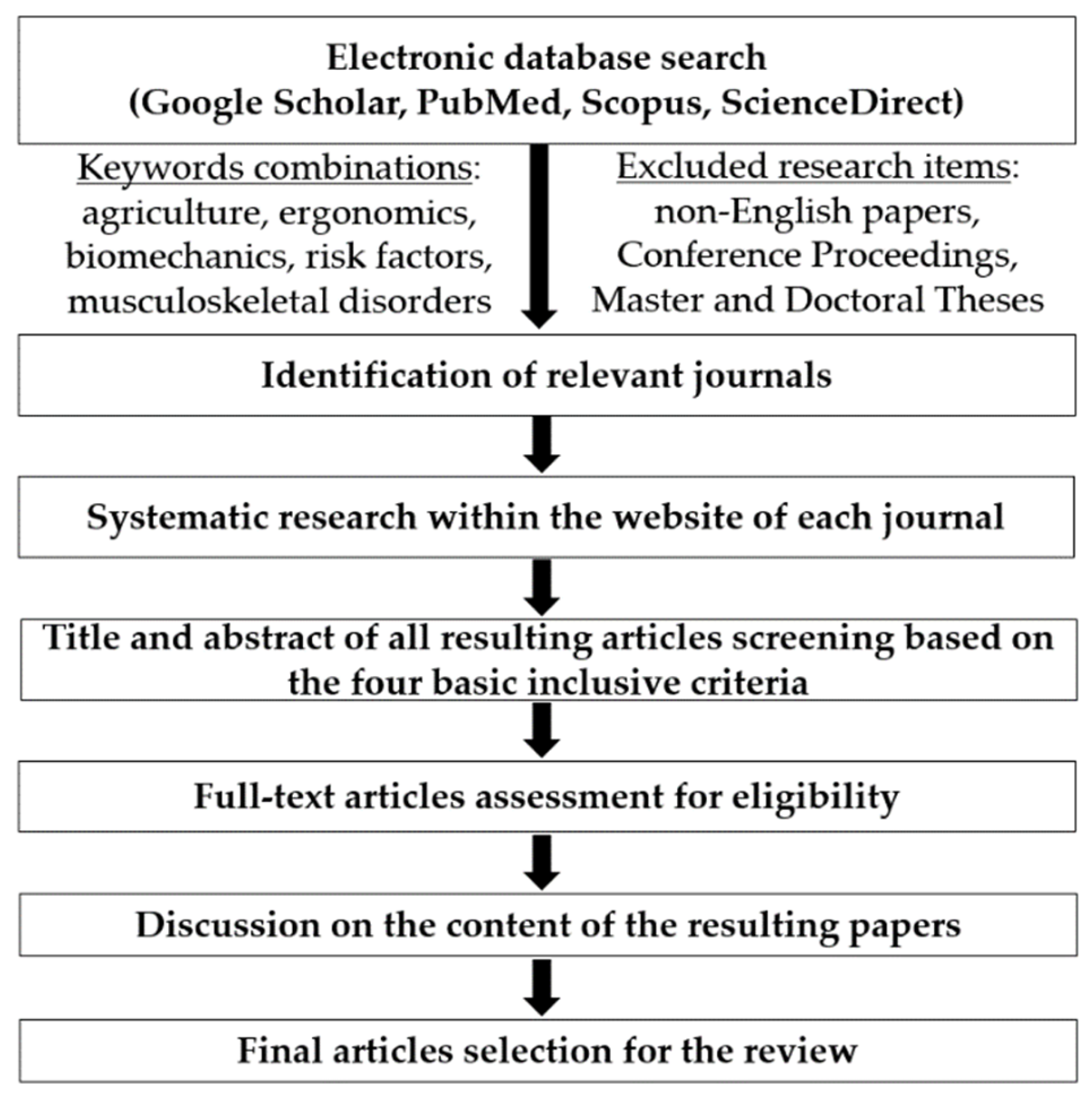
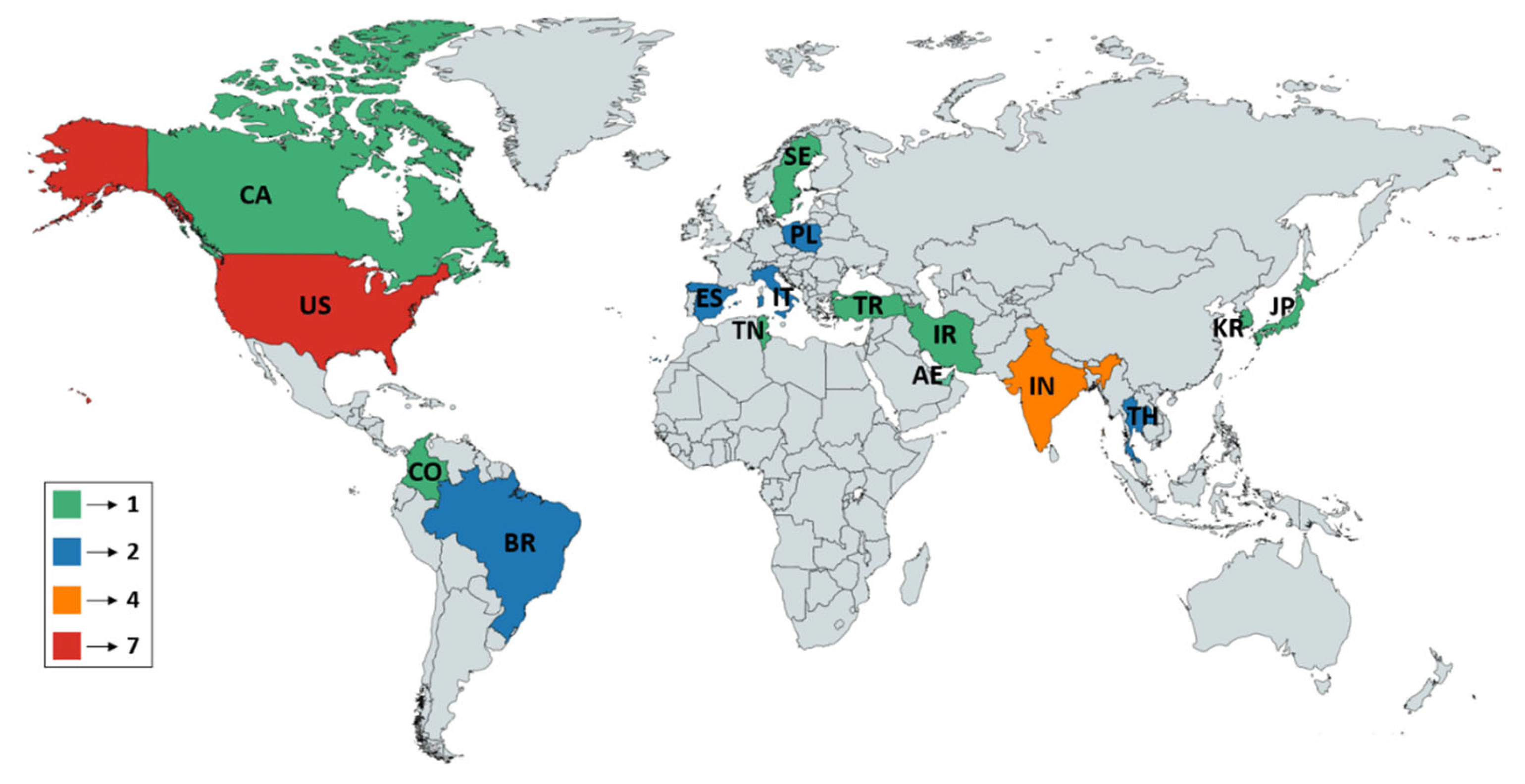

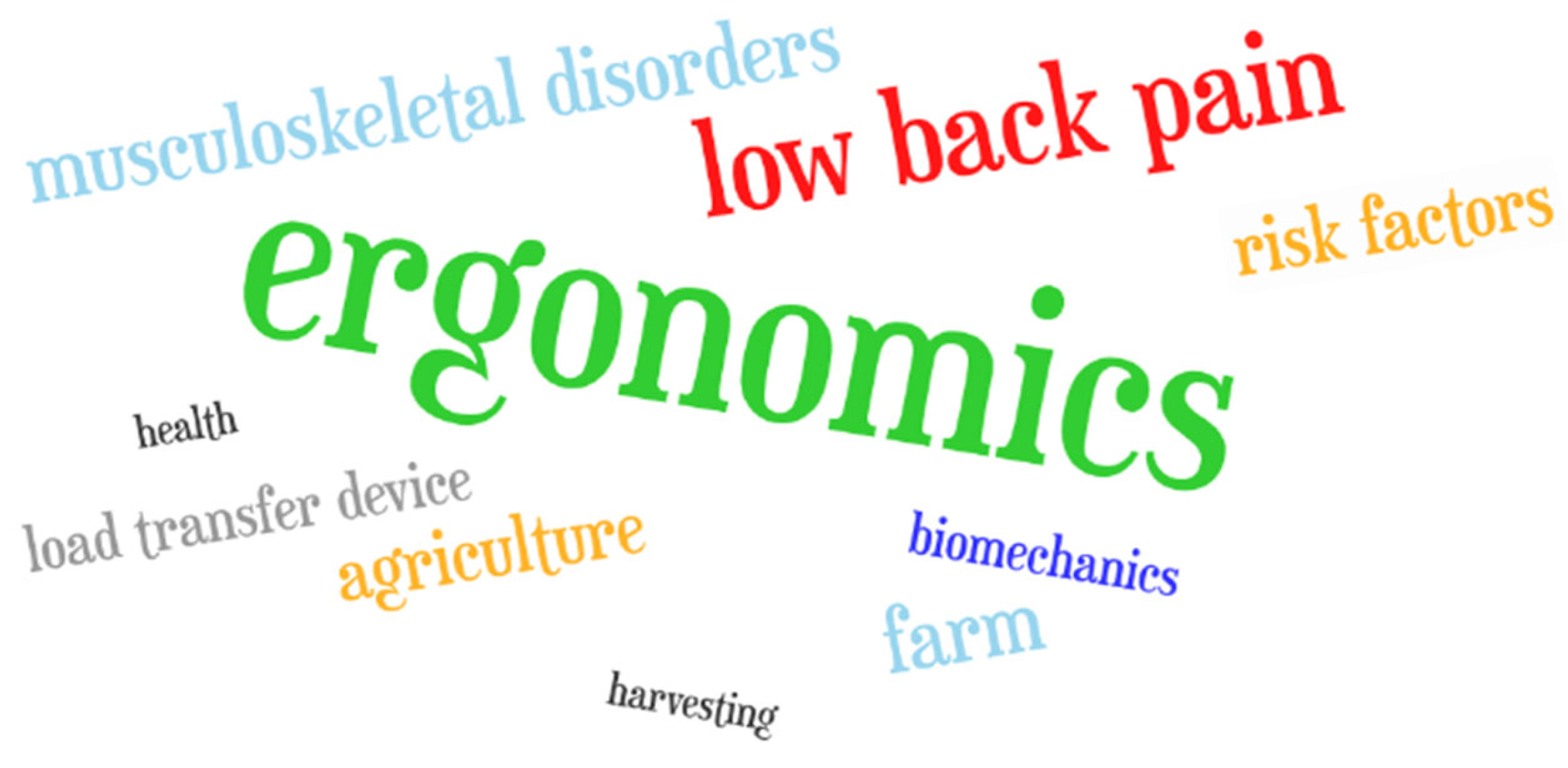
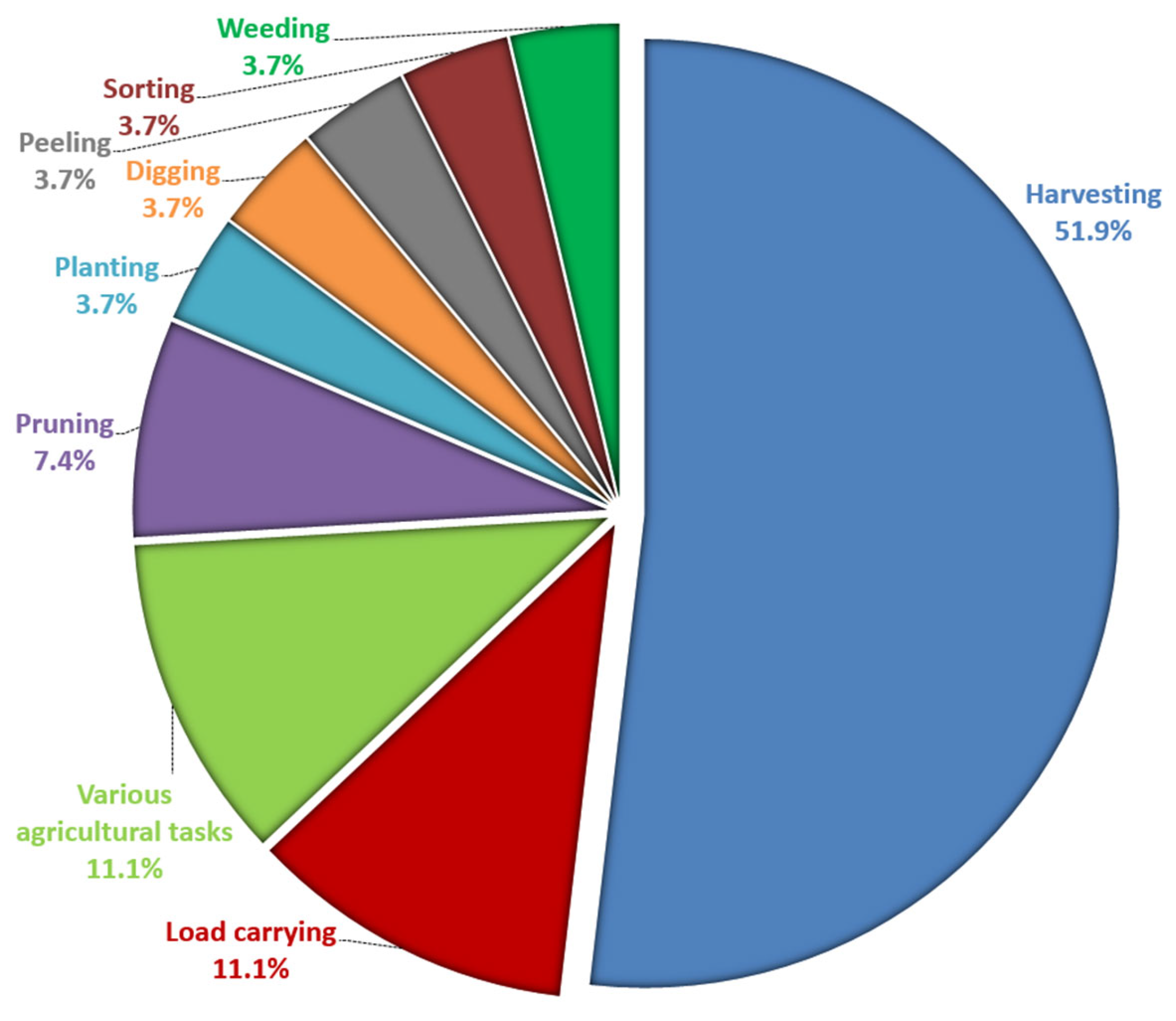
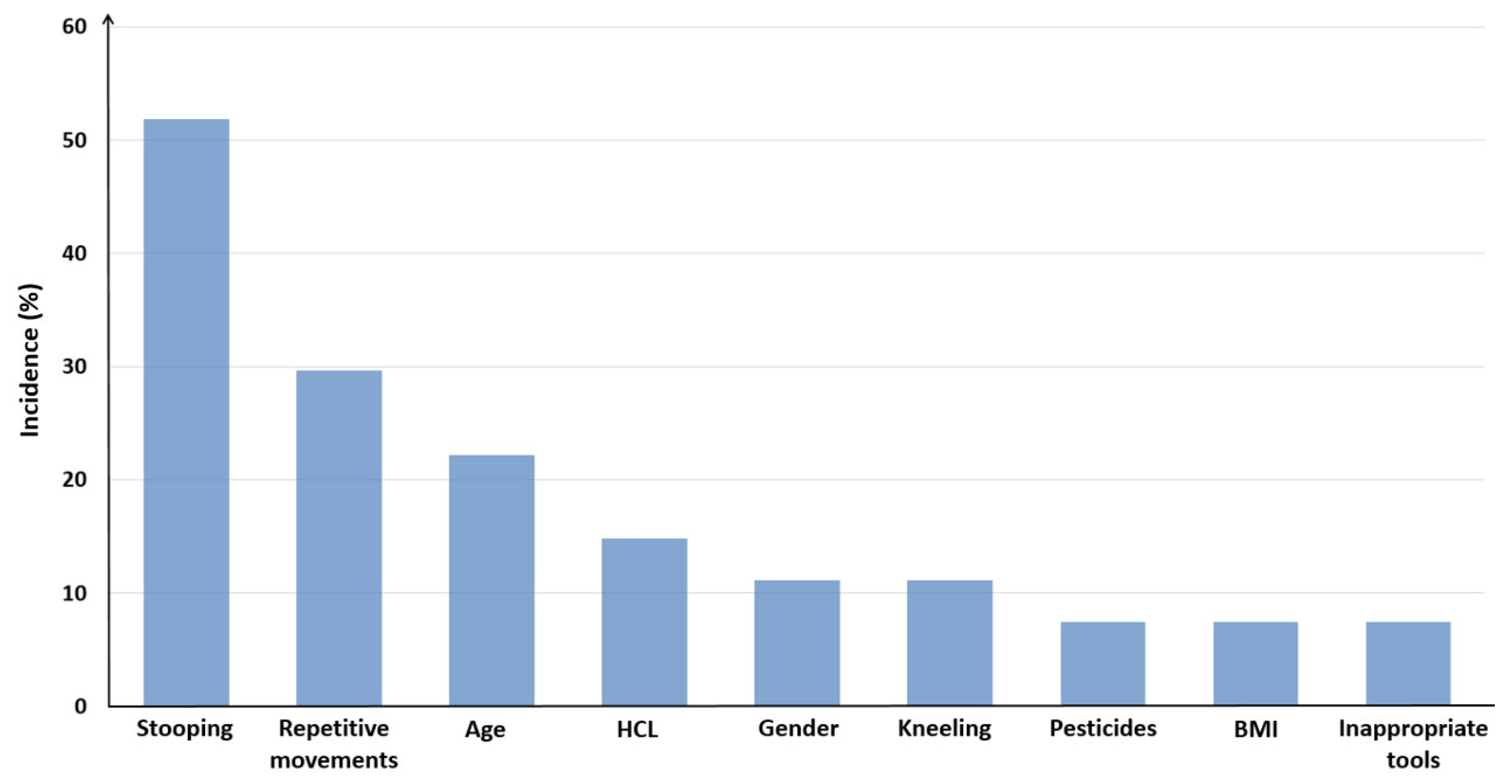
| Reference | Operation | Crop | Methods | Risk Factors |
|---|---|---|---|---|
| Cecchini et al. [36] | Harvesting | Tomato | OCRA | Repetitive movements of the upper limbs |
| Silverstein et al. [47] | Harvesting | Coffee | EMG, Musculoskeletal Quest, discussions | Stooping, HCL |
| Ulrey & Fathallah [35,44,45] | Harvesting | Low-growing crops | WTD, EMG, MEMS accelerator | Stooping |
| Ulrey & Fathallah [46] | Harvesting | Low-growing crops | Musculoskeletal models | Stooping |
| Boubaker et al. [70] | Sorting | Vegetable | Analytical model | Repetitive movements of the upper limbs |
| Hudson et al. [74] | Weeding | - | Segment end point optical markers | Stooping |
| Meucci et al. [38] | Harvesting | Tobacco | Quest | GTS, pesticides, awkward postures |
| Młotek et al. [41] | Harvesting | Apple | EMG, Tekscan system | Repetitive movements and strains of the upper limbs |
| Fathallah et al. [55] | Load carrying | - | 3D spinal EGM | HCL |
| Jena et al. [58] | Load carrying | - | Biomechanical model | HCL, ground inclination |
| Kang et al. [77] | Various tasks | - | Quest | Age, task type, ergonomic factors |
| Kumar et al. [69] | Peeling | Pineapple | Quest | Gender, age, working hours, experience |
| Pranav & Patel [48] | Harvesting | Orange | Polar heart rate monitor, Body pain sketch (Quest) | Repetitive movements, stooping |
| Udom et al. [39] | Harvesting | Rubber | Interview | Education, BMI, kneeling, pesticides |
| Berrio & Barrero [62] | Pruning | Flower | EGM, EMG, Borg scale | Rare pruner maintenance |
| Çakmak & Ergül [63] | Pruning | Sultana (grape) | Digital hand dynamometer | Anthropometric dimensions, ambient temperature |
| Houshyar & Kim [42] | Harvesting | Apple | NM Quest | Stooping, age |
| Jain et al. [43] | Harvesting | Wheat, rice | NM Quest, RULA | Stooping, age, gender, traditional tools |
| Juntaracena et al. [65] | Planting | Rice | Rotational rheometer, EMG, camera | Repetitive stooping, muddy terrain |
| Dewi & Komatsuzaki [68] | Digging | - | MTS, EMG, ECG, NM Quest | Repetitive stooping |
| Gómez-Galán [75] | Various tasks | Melon | Camera, OWAS | Kneeling, stooping |
| López-Aragón et al. [76] | Various tasks | Various crops | NM Quest | Age, gender |
| Pinzke & Lavesson [49] | Harvesting | Vegetable, strawberry | Quest, camera, interview | Kneeling, stooping with straight legs |
| Merino et al. [37] | Harvesting | Banana | NM Quest, dynamometer, IMU, EMG | Stooping, repetitive movements |
| Raczkiewicz et al. [57] | Load carrying | - | Quest | Early onset of menopause, age, BMI, repetitive HCL |
© 2020 by the authors. Licensee MDPI, Basel, Switzerland. This article is an open access article distributed under the terms and conditions of the Creative Commons Attribution (CC BY) license (http://creativecommons.org/licenses/by/4.0/).
Share and Cite
Benos, L.; Tsaopoulos, D.; Bochtis, D. A Review on Ergonomics in Agriculture. Part I: Manual Operations. Appl. Sci. 2020, 10, 1905. https://doi.org/10.3390/app10061905
Benos L, Tsaopoulos D, Bochtis D. A Review on Ergonomics in Agriculture. Part I: Manual Operations. Applied Sciences. 2020; 10(6):1905. https://doi.org/10.3390/app10061905
Chicago/Turabian StyleBenos, Lefteris, Dimitrios Tsaopoulos, and Dionysis Bochtis. 2020. "A Review on Ergonomics in Agriculture. Part I: Manual Operations" Applied Sciences 10, no. 6: 1905. https://doi.org/10.3390/app10061905
APA StyleBenos, L., Tsaopoulos, D., & Bochtis, D. (2020). A Review on Ergonomics in Agriculture. Part I: Manual Operations. Applied Sciences, 10(6), 1905. https://doi.org/10.3390/app10061905







